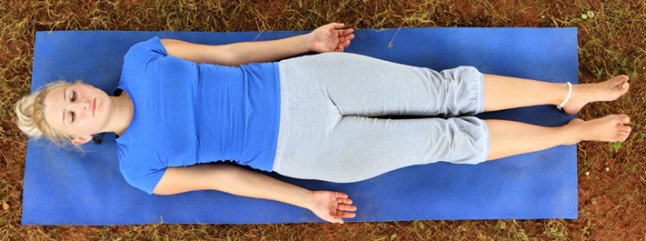Yoga brings deep rest to the body and mind. It not only rejuvenates your mind but also adds vigor to the body. It’s a good idea to end your daily yoga practice with Yoga Nidra or yogic sleep.
Simply described as an effortless relaxation, Yoga Nidra is an essential end to any yoga pose sequence. While yoga poses warm up the body, Yoga Nidra cools it down. This closing yoga asana involves consciously taking your attention to different parts of the body and relaxing them.
Yoga practices increase the energy levels in the body. Yoga Nidra helps conserve and consolidate this energy and relax the entire system, thereby preparing it for pranayama and meditation. It is, therefore, important to keep aside sufficient time for Yoga Nidra in your yoga regime.
How to do Yoga Nidra
- Lie down straight on your back in Corpse Pose (Shavasana). Close your eyes and relax. Take a few deep breaths in and out. Remember to take slow and relaxed breaths.
- Start by gently taking your attention to your right foot. Keep your attention there for a few seconds, while relaxing your foot. Then gently move your attention up to the right knee, right thigh and hip. Become aware of your whole right leg.
- Gently, repeat this process for the left leg.
- Take your attention to all parts of the body: genital area, stomach, navel region, chest.
- Take your attention to the right shoulder, right arm, palms, and fingers. Repeat this on the left shoulder, left arm, throat, face, and finally the top of the head.
- Take a deep breath in and observe the sensations in your body. Relax in this state for a few minutes.
- Slowly becoming aware of your body and surroundings, turn to your right side and keep lying down for a few more minutes. Rolling over to the right side makes the breath flow through the left nostril which helps cool the body.
- Taking your own time, you may then slowly sit up, and whenever you feel comfortable, slowly and gradually open your eyes.
Yoga Nidra instructions by Gurudev Sri Sri Ravi Shankar
Benefits of Yoga Nidra
- Cools down the body after yoga postures
- Restores normal temperature
- Activates the nervous system to absorb the effects of yoga asanas
- Energizes and relaxes the body
- Rejuvenates the mind
Getting ready for Yoga Nidra
- Yoga asanas, including Yoga Nidra, are best done on an empty stomach. It is not recommended to practice Yoga after a full meal.
- A comfortable clutter-free space.
- Some people may feel a little cold after Yoga Nidra, so, it is a good idea to keep a blanket handy.
Note: Yoga Nidra is not about ‘conscious effort’ but rather ‘conscious relaxation.’
You don't need to 'concentrate' or 'focus' on what a leg is or touch your nose. Nor do you need to move these body parts physically. You only need to gently take your attention to them, while taking deep breaths. The trick in Yoga Nidra is to relax with awareness, remain effortless, and consciously relax the body and mind.
It is quite natural to be distracted by random thoughts during Yoga Nidra. Do not try to curb them. If you fall asleep naturally, don't feel guilty once you wake up.
Yoga Nidra is thus a joyous, effortless way to end your yoga practice. Let go, relax and enjoy the experience that follows.
“As refreshing as sleep, I fondly call Yoga Nidra my 'super nap.' In just a short while, it leaves me deeply rested and freshened” shares Pritika Nair, an avid meditator.
This article is based on inputs by senior Sri Sri Yoga teachers: Dinesh Kashikar and Shriram Sarvotham.
Practicing Yoga helps develop the body and mind, yet is not a substitute for medicine. It is essential to learn and practice yoga under the supervision of a trained Yoga teacher. In case of any medical condition, practice yoga only after consulting your doctor and a Sri Sri Yoga teacher.
